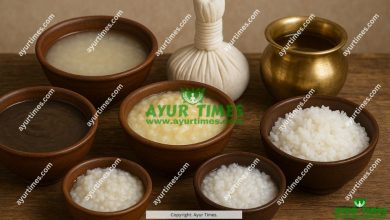Understanding Sama Dosha in Ayurveda: The Imbalance Within
In Ayurveda, health is a dynamic state of balance between the three fundamental energies or doshas—Vata, Pitta, and Kapha. These doshas govern all physiological and psychological processes in the body and mind. While balance (sama) among the doshas indicates good health, an imbalance (vishama) leads to disease. However, Ayurveda goes a step further by identifying a unique concept called Sama Dosha—not just an imbalance, but a toxified or impure state of the doshas.
What is Sama Dosha?
The term “Sama” means “with ama,” where ama refers to the toxic, undigested metabolic waste produced when digestion is weak or faulty. When doshas combine with ama, they become heavy, sticky, and more difficult to eliminate or pacify. This state is called Sama Dosha—a pathological form of the dosha that is mixed with toxins.
For example:
- Sama Vata: Vata mixed with ama
- Sama Pitta: Pitta mixed with ama
- Sama Kapha: Kapha mixed with ama
These are different from Nirama (pure or clean) doshas, which are easier to balance and treat.
How Does Ama Form?
Ama is typically formed when:
- Digestion (Agni) is weak or irregular
- Food is eaten in excess or incompatible combinations
- Meals are taken at inappropriate times (e.g., eating late at night)
- Emotions such as stress or worry disturb digestion
Ama is heavy, sticky, foul-smelling, and obstructive. Once it enters the bloodstream or combines with doshas, it leads to Sama Dosha, which can deposit in tissues, clog channels (srotas), and initiate disease processes.
Characteristics of Sama Dosha
Each type of Sama Dosha shows specific signs:
Sama Vata
- Pain with stiffness or heaviness
- Gas with foul odour
- Blackish or dark-coloured stools or urine
- Variable appetite with bloating
- Joint stiffness and tremors
Sama Pitta
- Fever with chills
- Sour or bitter burps with a foul taste
- Burning sensation mixed with heaviness
- Yellowish, sticky stool or urine
- Excessive thirst and irritability
Sama Kapha
- Thick mucus or phlegm with a bad odour
- Heaviness, lethargy, and sluggish digestion
- Sticky, white-coated tongue
- Loss of appetite and indigestion
- Dull headache and chest congestion
Importance of Differentiating Sama and Nirama Dosha
Ayurvedic diagnosis and treatment depend greatly on recognising whether a dosha is sama (with ama) or nirama (without ama). For example, treatments that pacify Vata may not work effectively in Sama Vata unless the ama is first removed. Administering oils or nourishing therapies in the presence of ama can worsen the condition.
Treatment Approach for Sama Dosha
The general approach is to first remove the ama, then pacify the dosha.
- Langhana (lightening therapies): Fasting, consuming light foods
- Pachana (digestive stimulation): Herbs and spices like ginger, black pepper, trikatu
- Deepana (enhancing digestive fire): Use of formulations like Hingvastak Churna, Trikatu Churna
- Shodhana (purification): Once ama is reduced, Panchakarma may be recommended
- Dietary Correction: Warm, easily digestible foods; avoidance of heavy, oily, or cold items
- Lifestyle Adjustments: Regular routine, stress management, and physical activity
Final Thoughts
Sama Dosha is a core diagnostic concept in Ayurveda that highlights the importance of metabolic health. It teaches us that before correcting doshic imbalances, we must first address the root—ama. Paying attention to digestive signs, tongue coating, appetite, and energy levels helps detect ama early. Restoring Agni (digestive fire) and cleansing the body through proper therapies ensures a return to balance and vitality.
By understanding Sama Dosha, we deepen our grasp of Ayurvedic healing and move closer to true wellness—where the body is light, the mind is clear, and life flows effortlessly.

